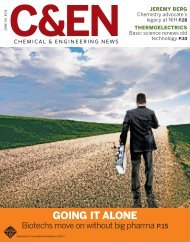Chemical & Engineering News Digital Edition ... - IMM@BUCT
Chemical & Engineering News Digital Edition ... - IMM@BUCT
Chemical & Engineering News Digital Edition ... - IMM@BUCT
You also want an ePaper? Increase the reach of your titles
YUMPU automatically turns print PDFs into web optimized ePapers that Google loves.
EMPLOYMENT OUTLOOK<br />
COURTESY OF PHOENIX IPY TEAM<br />
EXTREME CHEMISTRY<br />
Chemists working in extreme environments<br />
mix SCIENCE WITH ADVENTURE<br />
LINDA WANG, C&EN WASHINGTON<br />
SHIVERING INSIDE a tent in an isolated<br />
area of Antarctica, Tufts University professor<br />
of chemistry Samuel P. Kounaves could<br />
barely feel his fingers as he tried to keep the<br />
solution in his pipette from freezing. Outside<br />
the tent, the temperature was −30 ºC.<br />
The barren, cracked land in these so-called<br />
dry valleys looked eerily like Mars.<br />
In fact, that’s the reason Kounaves and<br />
colleagues embarked on this three-week<br />
expedition in December 2007. They wanted<br />
to do a trial run of analytical instruments<br />
that would be taken to Mars by the Phoenix<br />
Lander, and these dry valleys in Antarctica<br />
are similar to some regions of the red planet.<br />
“In chemistry, you think a lot of us just<br />
want to be in the lab, but, in reality, I think<br />
a lot of chemists are extroverts and they<br />
enjoy going out into the world and doing<br />
things,” Kounaves says. “We’re explorers<br />
at heart.”<br />
Kounaves isn’t alone in seeking answers<br />
to scientific questions in such<br />
extreme environments. As chemistry<br />
becomes increasingly interdisciplinary,<br />
chemists are finding more opportunities<br />
to do fieldwork, which has traditionally<br />
been the domain of researchers in the<br />
natural sciences, in areas such as oceanography<br />
and vulcanology. In this stormy job<br />
market, the ability to work at the intersection<br />
of multiple scientific disciplines and<br />
to be imaginative about how chemistry<br />
is applied to big-picture problems could<br />
provide a safe haven.<br />
Fieldwork can take many forms, from a<br />
local half-day trip to a monthlong excursion<br />
to the other side of the world. The<br />
example of Kounaves and two other chemists<br />
working on the far end of the spectrum<br />
demonstrates that there’s no limit to what<br />
chemists can do.<br />
Tamsin A. Mather, an academic fellow<br />
in the earth sciences department at the<br />
University of Oxford, understands the<br />
trials and tribulations of doing fieldwork<br />
in extreme environments. She studies the<br />
atmospheric chemistry of volcanic plumes<br />
and their effects on the environment.<br />
Mather says that the most extreme place<br />
she’s worked in is Lascar Volcano, in the<br />
Chilean Andes. What made it so challenging<br />
for her team is the high altitude, which<br />
MORE ONLINE<br />
WWW.CEN-ONLINE.ORG 55 NOVEMBER 3, 2008<br />
COLD ROOM<br />
Inside a tent<br />
in Antarctica,<br />
Kounaves<br />
analyzes<br />
data on soil<br />
samples.<br />
made the climb to the<br />
summit—while carrying<br />
all their equipment—that<br />
much more difficult. Not<br />
only that, but the remotesensing<br />
device they<br />
had brought with them<br />
stopped working. “You always<br />
try to anticipate problems,” she says.<br />
“But of course, things always occur that<br />
you can’t anticipate.”<br />
At the same time, Mather says she<br />
wouldn’t trade the experience for the<br />
world. “I feel privileged to be able to work<br />
in some really beautiful places,” she says.<br />
Mather has also studied the gas geochemistry<br />
of volcanoes in Hawaii, Nicaragua,<br />
and Italy.<br />
IF RESEARCH atop volcanoes isn’t exciting<br />
enough, imagine spending an entire<br />
day in a tiny closet with two other people.<br />
That’s what it feels like in the deep-sea<br />
submersible Alvin, says George W. Luther<br />
III, the Maxwell P. & Mildred H. Harrington<br />
Professor of Oceanography at<br />
the University of Delaware, who studies<br />
sulfur and iron biogeochemistry at hydrothermal<br />
vents.<br />
Alvin’s chamber, essentially a titanium<br />
ball that’s seven feet in diameter, is so small<br />
that only one person can stand at a time.<br />
The other two people have to be lying flat<br />
in the ball, and sometimes their legs get<br />
tangled, Luther says. What’s more, there<br />
are no bathrooms, heating, or air conditioning.<br />
“It’s exhausting going down in Alvin,”<br />
says Luther of the daylong dives. “It’s<br />
one of the most intense days of science<br />
you’ll ever have in your life.”<br />
Inside Alvin, a pilot navigates the submarine<br />
to areas where hot chemicals are spewing<br />
out of hydrothermal vents or farther<br />
down the chimney where all the organisms<br />
are. Using laptops that are wired through<br />
the hull, Luther and the other scientists<br />
collect data from sensors attached to the<br />
outside of Alvin.<br />
“Our goal is to try to understand the<br />
chemistry that these organisms are living in<br />
so we can better understand why they live<br />
in the ecological niches that they live in,”<br />
Luther says. “There’s an awful lot that we<br />
don’t know about how they uptake chemicals<br />
and perform their chemosynthesis.”<br />
Luther’s research cruises have included<br />
deep-sea expeditions in the Mediterranean<br />
Experience what it feels like to sit in the passenger seat of<br />
Alvin, a deep-sea submersible, at www.cen-online.org.

















